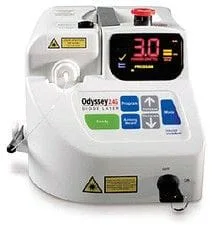
Odyssey 2.4 G Diode Laser
The Odyssey® Diode Lasers are dentistry's most user-friendly soft tissue laser to date. With a simplified control panel, the Odyssey® Diode Lasers feature the latest and finest solid state diode laser technology, accurate power output and a consistent wavelength for smooth, precise, clean tissue modification.
The term laser stands for "Light Amplification by Stimulated Emission of Radiation", which means a device that produces and amplifies light. The wavelength of the light produced will determine what types of tissues can be
modified by the light's energy. Light waves that emanate from within the visible and near-infrared portions of the electromagnetic spectrum will be readily absorbed into body pigments like melanin in the skin, and heme found
within hemoglobin in blood. They will have virtually no affinity for water and thus, it won't be absorbed at the surface as it enters soft tissues. Wave lengths located within the mid to far infrared range are attracted to water and the Hydroxyapatite crystals that are found within bone and teeth. Thus, these wave lengths are primarily used in hard tissue lasers. With a frequency of 810+/-20 nanometers, the Odyssey Diode Laser's wave length falls into
the lower end of the near-infrared spectrum, making it suitable for soft-tissue applications.
Laser light can be emitted in either a continuous or pulsed temporal mode and the Odyssey Diode Lasers are designed to deliver both. Lasers require a power supply and an active medium in order to produce light. Dental lasers employ different active mediums such as the man made rods found in the YAG lasers, liquids, gases or solid state semi-conductor crystals like those found in diodes. The Odyssey Diode Lasers feature an Aluminum, Gallium and Arsenide semi-conductor crystal that is activated or 'pumped' when an electrical current
is passed through it, and it then produces an elliptical shaped display of monochromatic light. This light is then focused into a very small thread of light and directed into a fiber-optic which carries it to the target tissue. The resultant photo-thermal reaction results in vaporization at the cellular level.
The laser creates an intense beam of light energy that moves through a fiber optic cord. When it enters the targeted tissue, the energy is converted into heat as a result of the tissue's pigmentation. A photo-thermal reaction occurs
that results in a much localized thermal effect causing vaporization (or ablation) of this targeted tissue, with 'very little collateral tissue damage.'
The primary use of a soft-tissue laser is the modification or removal of intra-oral soft tissue. The photo-thermal effects of the laser's energy allow the operator to modify tissues and control hemostasis at the same time by coagulation. The post-operative response of the laser care will usually produce a cleaner and healthier surgical site with less discomfort when compared to alternative methods of surgery. Soft tissue lasers enable minor surgical procedures and decontaminate the area at the same time. There is less chance of infection, and some soft tissue procedures around the gingiva can be completed without anesthesia.
The laser also promotes healing for infected and irritated tissues. Since there is a favorable response to laser treatment, the resultant healing is less complicated and often shorter when compared to traditional techniques.
In many cases, the laser can also be used to treat deep gingival pockets that harbor bacteria and cause gum disease. An additional benefit of dental diode laser technology is its ability to reduce the pain and longevity of cold sores and fever blisters.
